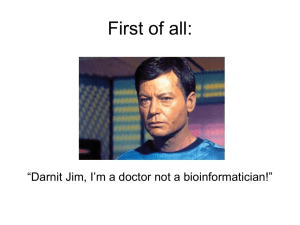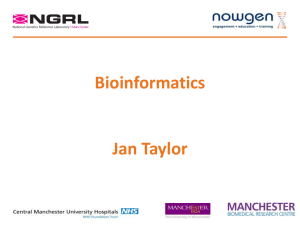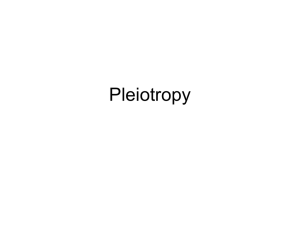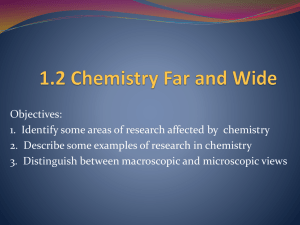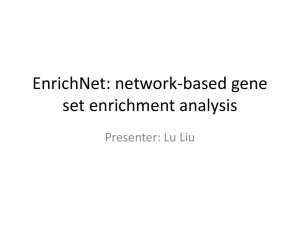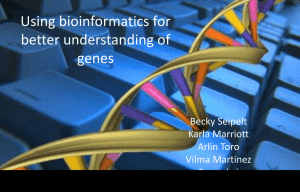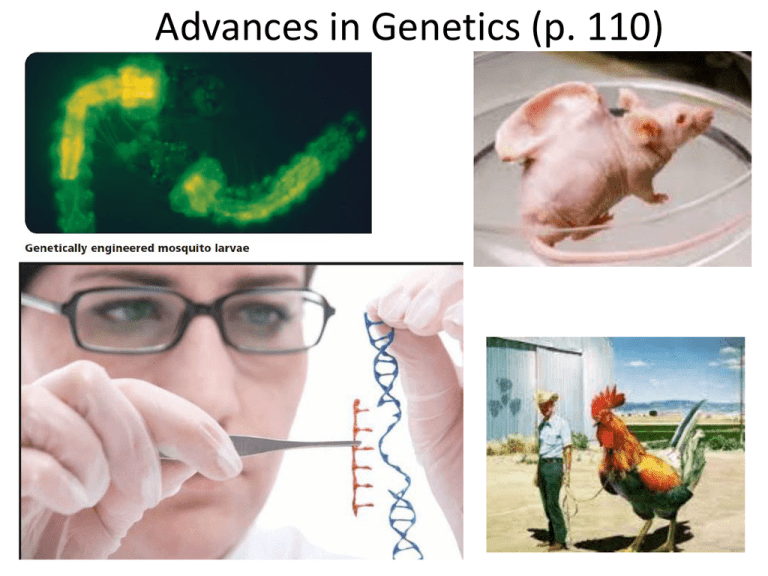
Advances in Genetics (p. 110)
Genetic Engineering
• Technology that involves modifying
the DNA of one organism by
inserting the DNA of another.
• First used in the
1970s
• Today is used in
a wide variety of
applications
Uses of Genetic Engineering
• 1. Pharmaceutical (production of medicines)
• 2. Gene Therapy (a way of treating some
disorders and diseases that usually involves replacing bad
copies of genes with other genes)
• 3. Food improvement (introducing
genes from other species that gives food (plant/animal) a
benefit to mankind.
How do we put a new gene into an
organism?
• Recombinant DNA is DNA that is moved from one
species into another.
• Genetically Modified Organism(GMO): An
organism that has recombinant DNA.
Glow in the dark rabbits
Moving Genes
• A vector is used to move a gene from one
species into another
• Two common vectors are plasmids (small
loops of DNA) and viruses (a some DNA in
proteins that can use a cell to copy itself)
• After the gene has been put in, it can be
copied by the organism and used to make
proteins
Humans need human insulin!!!
• Ever heard of Diabetes당뇨병 ???
• There are different types of diabetes, the most
common type requires people to take
injections of insulin인슐린 .
• In the past, we got insulin from the
pancreas췌장 of pigs.
Do you want pig
insulin??? Oink
oink
Why would we want a bacteria to
make a human protein????
• Pig insulin works, but it is not 100%
identical.
• Also, you need to take it out of a pig
pancreas
• Using insulin as our example, lets
understand how companies can now
make human insulin for humans, using
our friends, BACTERIA
Cloning a gene
• Insert a gene into a vector (e.g. plasmid),
which is placed inside a bacterium
• The recombinant gene is then copied and
copied by the bacterium
• When the bacterium reproduces asexually,
it will copy the recombinant gene
Step 4: bacteria makes human insulin
Step 3: put the
recombinant
plasmid in the
bacteria
Step 2: paste in
any gene (e.g.
insulin) using the
enzyme ligase
Step 1: cut piece of
plasmid out with
restriction
enzymes
Pharmaceutical Benefits of Biotechnology
• Human growth hormones, insulin and many
other human products can be made large-scale
using cloning. The advantages are the product is
actually human, can be made in large amounts
and can be made less expensively.
Viruses
• Are “bad”
• Cause illnesses
• They shoot their
genetic material
into the nucleus
of the human cell
• The human cell
makes more
viruses
(transcription and
translation of
virus proteins)
Viruses hijack납치the cell
Gene Therapy
• Put normal
allele in a cold
virus
• Inhale the cold
virus
• The virus infects
your nasal cells
• The normal
allele goes into
the nucleus
• The cell can
make the
normal protein
Gene Therapy
Cystic fibrosis
• CF is caused by a
mutation in the gene
for the protein cystic
fibrosic
transmembrane
conductance
regulator (CFTR).
This protein is
required to regulate
the components of
sweat, digestive
fluids, and mucus.
What if…………
• Scientists removed the illness-causing genes
from a virus
• Well, the virus could infect your cell, but not
cause damage.
• Scientists inserted some “good” genes that a
person is missing (e.g. cystic fibrosis gene)
• Well, the virus could give the human cell this
new gene like it used to give the old bad virus
genes.
Types of Gene Therapy
• Body cell: deliver gene
to the body cell. Not
passed on to the next
generation. This type is
has been used in
human clinical trials.
• Sex cell: deliver gene
to the sex cells so it is
passed on to the next
generation. Many
countries have not
allowed this for human
clinical trials.
Risks of Gene Therapy
• Short-lived success: what if the “good” gene
doesn’t go inside the genome (one of the
chromosomes). The gene is “lost”
• Possible Immune system response: the virus
is still “foreign”, maybe your body will fight it.
• May cause cancer: what if the “good” gene
goes inside a cell cycle gene. Then your cell
cycle is broken (cancer). Hope it jumps into
junk DNA
Genetically Modified Food
• These foods have genes that do not
belong to them. They are from other
species. They have been designed to
have “something” better
How to make crops better?
• Arctic Flounder Fish: The Arctic Flounder Fish
produces an anti-freeze that allows it to
protect himself in freezing waters.
Bt corn
• Insert a
bacteria
(Bacillus
thuringiensis)
gene that
makes a toxin
into corn.
• Greater yield
• No use of
pesticides
Bt Corn
• Clone the Bt toxin gene then
insert it into the corn genome
Why stop Bt corn?
• Environmental concerns
(poison to other insects?)
• Allergies to
the toxin in
humans
“Golden” rice
• Scientists added bacteria and
daffodil gene.
• Adds Vitamin A
• Lack of vitamin A kills 670,000
kids a year under age 5
수선화
“Golden” rice
Banana vaccines?
• Virus injected into
a banana sapling.
• Virus proteins are
now part of the
banana
• Creates an
immunity to the
virus.
Pollution fighting plants
• Plants
engineered to
have genes
used for
removing
contamination
from the
ground water
Pros
Increased pest
해충, 유해 동물
and disease
resistance병저항
성
Cons
Introducing allergens and toxins to
food
Accidental contamination between
genetically modified and nongenetically modified foods
Drought
Antibiotic resistance
tolerance내건성
Increased food
supply (yield,
nutrition, vaccine)
Adversely changing the nutrient
content of a crop
Creation of "super" weeds and other
environmental risks


